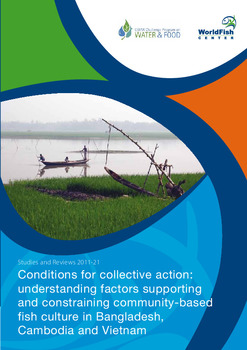Conditions for collective action: understanding factors supporting and constraining community-based fish culture in Bangladesh, Cambodia and Vietnam
Abstract
In 2005, the WorldFish Center embarked on a project to pilot test approaches to community-based fish culture (CBFC) in five countries. A previous study conducted between 1997-2000 demonstrated the potential of the approach in Bangladesh and Vietnam, although a greater understanding was needed regarding the social and institutional factors that would permit the development of CBFC in larger waterbodies to reach a greater number of beneficiaries. The five countries selected for dissemination of CBFC included Cambodia, Vietnam, China, Bangladesh and Mali, each very different in terms of history, politics, social-cultural context, aquaculture experience and development status. They appeared to share environmental characteristics, all having seasonally flooding areas and experience of rice-fish culture. This report presents the findings of this study, based on a detailed evaluation undertaken in 2008-2009 in Cambodia, Vietnam and Bangladesh. Mali and China were not included in the study, both for reasons of time and cost, and due to the different path that project development had taken in each country. Although the research was conducted as consistently as possible across the three countries, using the same methodology in each location, the results are nonetheless also indicative of the differences encountered at each location. The diversity of reasons why CBFC worked and didn’t work led to difficulties in drawing conclusions across countries, or in quantifying results, with the exception of Vietnam where the number of communities involved in the study made quantification possible. The findings of the study are therefore primarily qualitative in nature, with figures provided relating to number of responses where available. The issues raised by respondents participating in the study are grouped according to environmental conditions, socio-cultural conditions, livelihood context, institutional context, markets and economic viability, technical issues and implementation and incentives and disincentives for uptake and continuance. The report concludes with a summary of lessons learned

